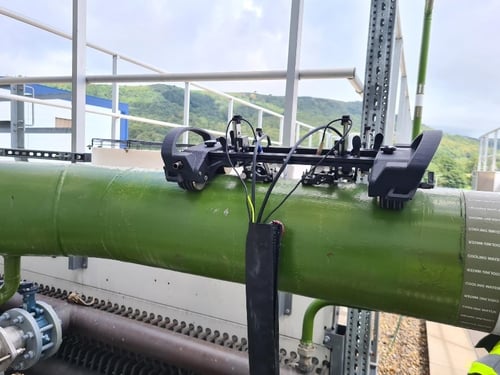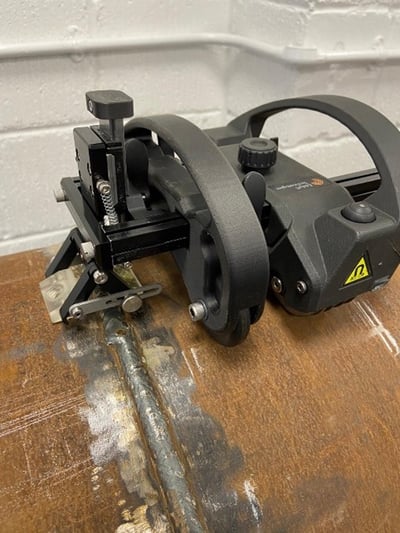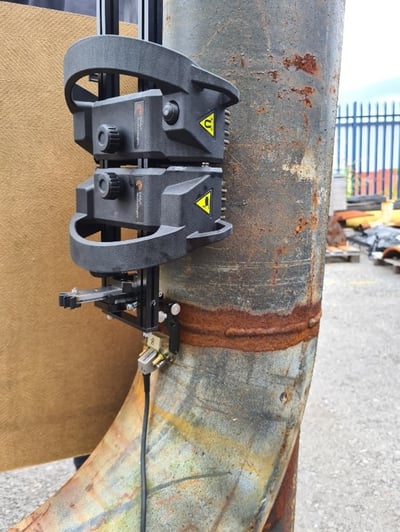Lors de l'introduction initiale des méthodes automatisées de contrôle par ultrasons, l'accent a été mis sur les soudures de tuyau à tuyau avec un accès approprié pour le balayage des deux côtés.
Le contrôle par ultrasons à réseaux phasés (PAUT) et la diffraction par temps de vol (TOFD) ont été rapidement acceptés comme des alternatives appropriées à la radiographie et sont désormais considérés comme une technologie mature pour les soudures de configuration standard.

Figure 1 : Soudure conventionnelle d'un tuyau à l'autre avec accès aux deux côtés
Alors que les propriétaires d'actifs ont bénéficié de la réduction de la radiographie pour les activités sur site, il y a eu une augmentation des demandes d'introduction de PA/TOFD pour toutes les variations de soudures. L'instrumentation d'Eddyfi Technologies est capable de créer des lois focales conformes au code pour une variété de configurations de soudure différentes, et maintenant avec l'introduction de LYNCS™ WI, nous pouvons offrir une solution clé en main pour les joints soudés auparavant difficiles à inspecter.
Soudures entre tubes et raccords
De nombreuses sections droites de tuyaux ne sont pas soudées à d'autres sections droites et peuvent souvent former un joint au niveau des coudes, des brides ou même des raccords. Lors du contrôle des soudures bout à bout volumétriques, il est important d'examiner les deux faces de fusion à des angles optimaux ou à l'aide de méthodes UT, telles que le TOFD, qui ne sont pas affectées par l'orientation des défauts. Lors du contrôle de joints soudés complexes, une méthode courante consiste à utiliser un réseau phasé d'un côté de la soudure, suivi d'une configuration TOFD pour inspecter la face de fusion du côté de l'armature. Pour effectuer cette inspection, le scanner LYNCS WI monte toutes les sondes PA/TOFD nécessaires et est configuré mécaniquement pour les surfaces de scanner disponibles. L'image ci-dessous montre l'arrangement recommandé pour l'inspection des soudures aux coudes.

Figure 2 : Scanner à accès restreint avec un scanner TOFD dédié pour l'évaluation de la face de fusion du côté le plus éloigné.

Figure 3 : Inspection unilatérale d'une soudure entre un tuyau et un coude à l'aide d'un réseau phasé et d'un scanner LYNCS modifié.
Soudures austénitiques
Les soudures austénitiques ont toujours été considérées comme problématiques pour le contrôle par ultrasons. La structure à gros grains des soudures, associée au changement de structure des grains à la limite de la soudure, était souvent considérée comme trop atténuante pour obtenir un rapport signal/bruit fiable. Cependant, grâce aux améliorations apportées à l'instrumentation, aux fonctionnalités du logiciel Capture™ et à l'utilisation de sondes à double matrice (DMA) spécialement conçues pour les soudures austénitiques, le PA est désormais une solution fiable pour ce type de joints. Le LYNCS CHAIN, récemment lancé, est la solution de scanning parfaite pour ce type de joints de tuyauterie. Le matériau austénitique étant non ferreux, les scanners magnétiques traditionnels ne sont pas pratiques. L'ajout de l'accessoire LYNCS CHAIN permet à l'utilisateur de bénéficier de tous les avantages du scanner LYNCS sans avoir besoin d'une adhésion magnétique. La chaîne offre une précision maximale pour le placement des sondes et des ensembles de données entièrement enregistrables pour la couverture des soudures.

Figure 4 : Inspection de l'acier inoxydable à l'aide de deux sondes DMA et inspection des soudures par fluage
La nouvelle ère de la tuyauterie en plastique
Les canalisations en polyéthylène haute densité (PEHD) sont une alternative de plus en plus populaire aux canalisations en acier traditionnelles, comme nous l'expliquons ici. Tout comme les contraintes mécaniques des tuyaux en acier inoxydable, les tuyaux en plastique sont également non ferreux et nécessitent un mécanisme de balayage qui offre un haut degré de précision pour le positionnement des sondes. Toutefois, contrairement à l'inspection des soudures en acier inoxydable, il est courant d'utiliser une sonde à faisceau droit pour le PEHD. Pour les joints par fusion électronique, la méthode d'inspection préférée consiste à utiliser un faisceau droit à zéro degré avec une chemise d'eau et à balayer directement le joint. Ce type de joint soudé est également parfaitement adapté à LYNCS CHAIN, qui accueille cette fois la sonde Eddyfi Aqualock avec une colonne d'eau portable. C'est l'un des principaux atouts de la famille des scanners LYNCS. Avec un fonctionnement sans outil et des réglages polyvalents, le même scanner peut être utilisé dans une large gamme d'applications en sélectionnant simplement les sondes PA/TOFD adéquates pour cette application. Il n'y a rien de mieux que cela !
Conclusion
La radiographie présente certainement des avantages uniques pour certaines applications CND, mais le plus souvent, les propriétaires d'actifs profitent des économies significatives et des améliorations de la sécurité offertes par l'adoption de l'UT avancée. Les défis posés par les joints complexes, les matériaux à structure grossière et les surfaces de balayage non ferreuses sont progressivement surmontés. La puissance des instruments PAUT d'Eddyfi Technologies, les flux de travail intuitifs du logiciel Capture, qui sont les meilleurs de leur catégorie, et la famille de scanners LYNCS, très polyvalente, ont fait de l'inspection des soudures difficiles une chose du passé.
Contactez notre équipe d'experts pour savoir comment optimiser votre prochaine campagne d'inspection et rester dans l 'air du temps!





